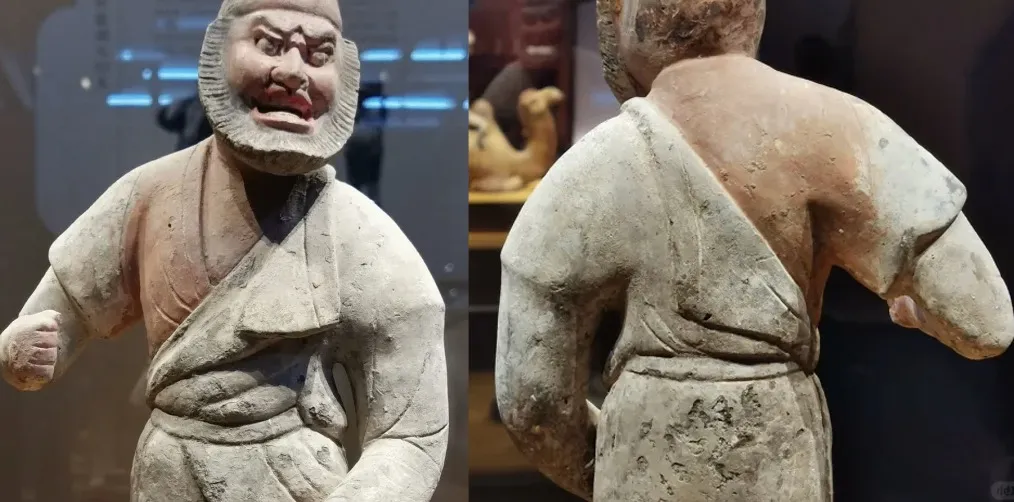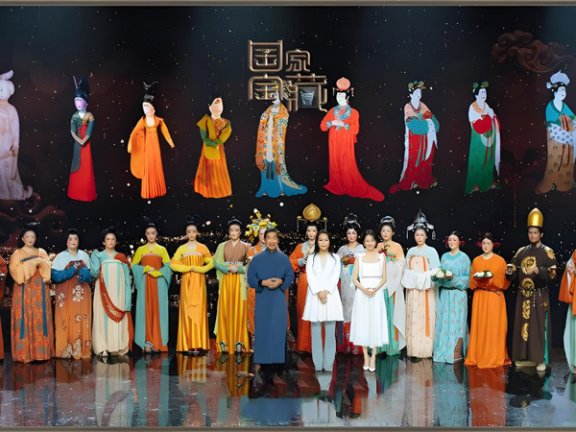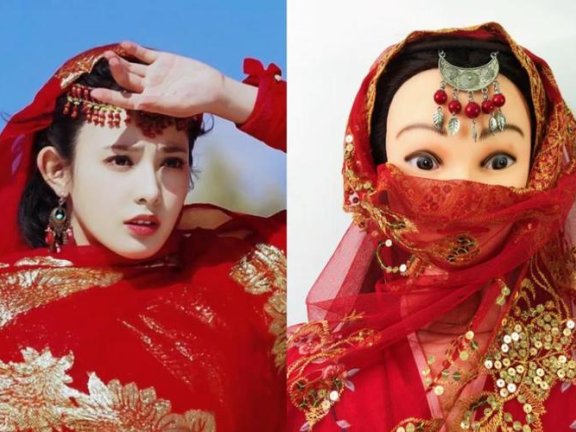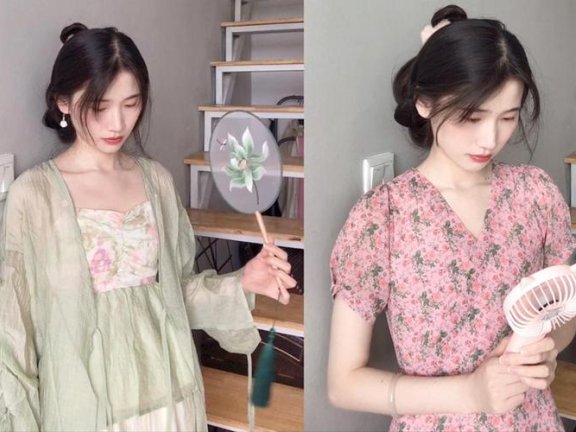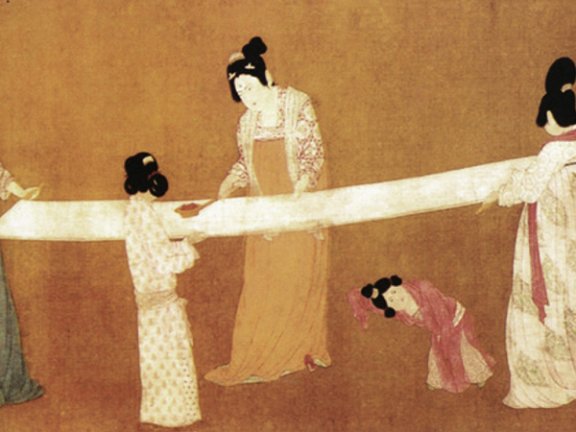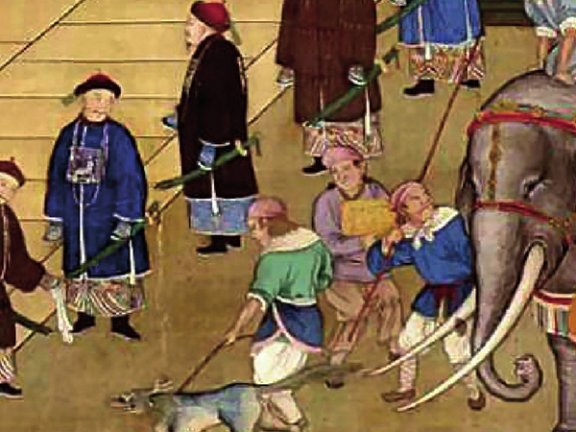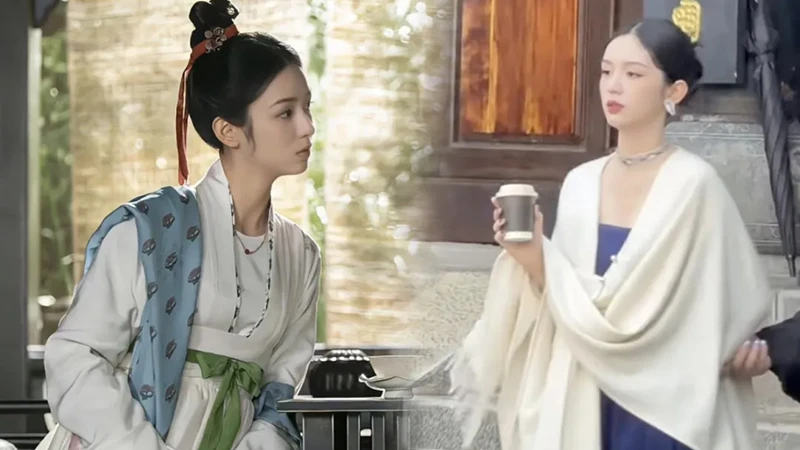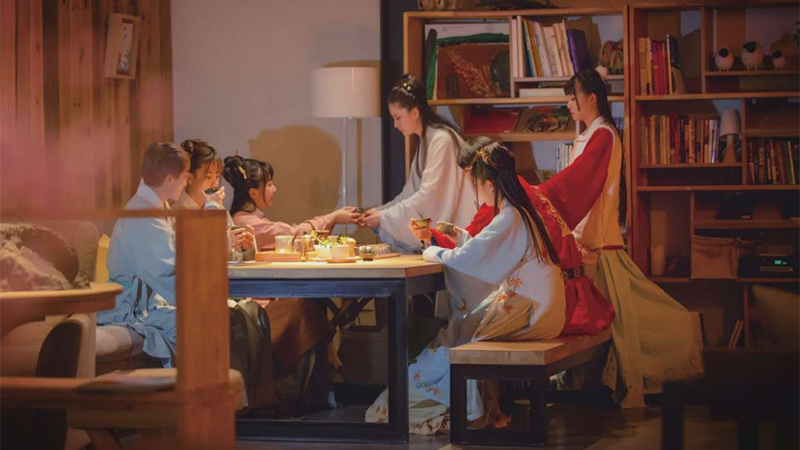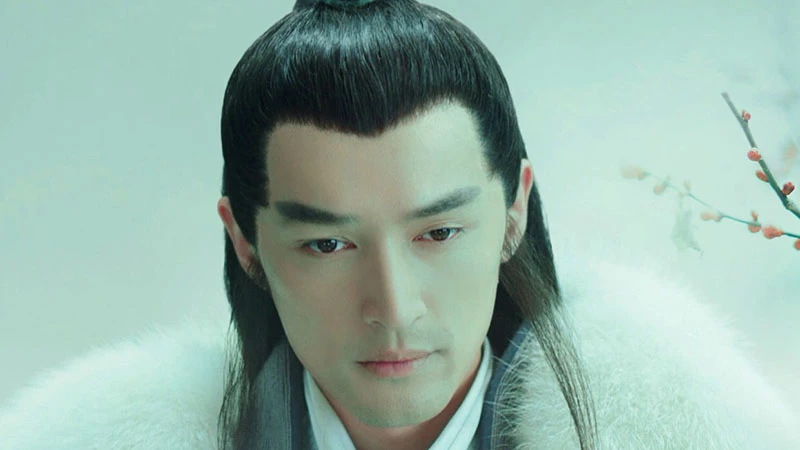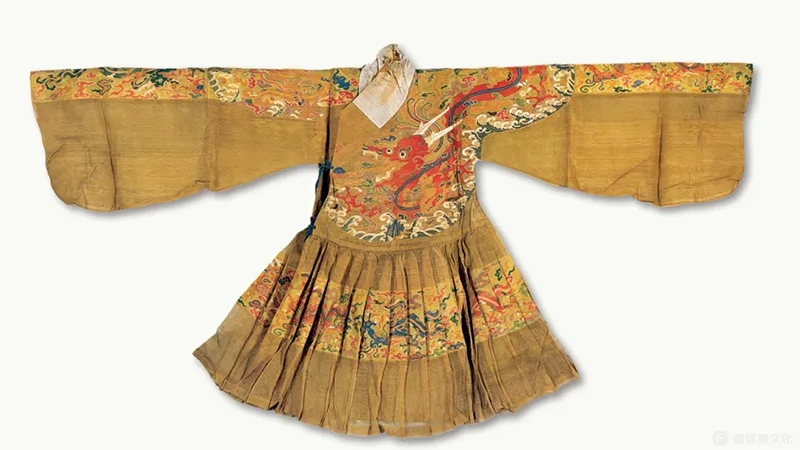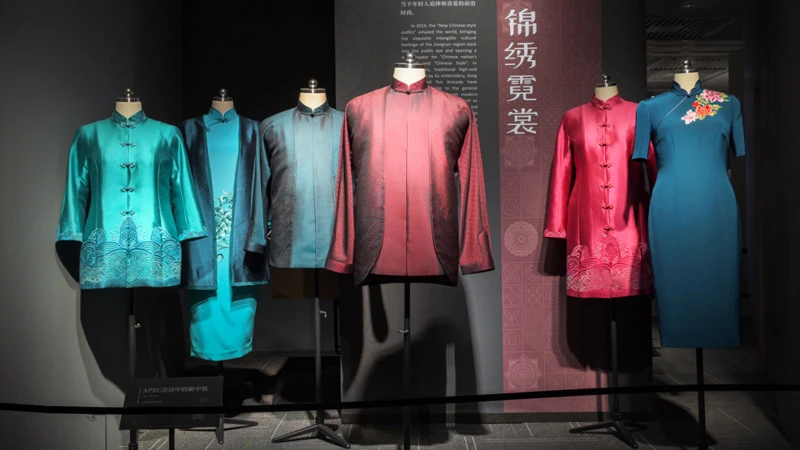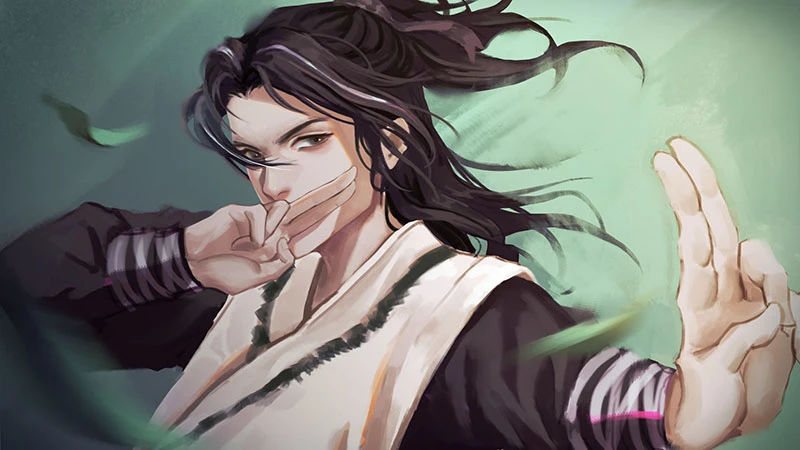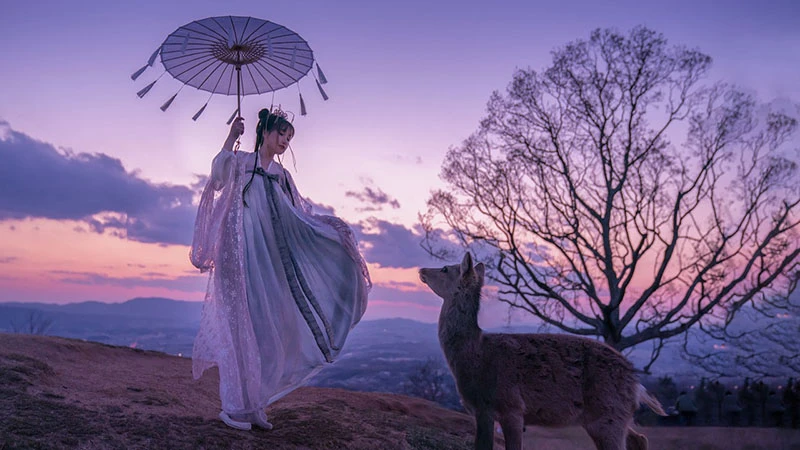-
Did Han Dynasty Men Wear High-Collars?
A recent period drama costume has ignited curiosity about ancient Chinese fashion. Actor Liu Xueyi (刘学义) appeared in promotional images wearing a high-necked inner garment, a style unfamiliar to many modern viewers. Fans quickly dubbed it the "neckless" undershirt, sparking online discussions about its historical accuracy. This sartorial detail is not a costume designer's fantasy but a potential revival of a real, yet enigmatic, item from the Han Dynasty known as the Quling (曲领). The debate surrounding Liu's attire mirrors a century-old academic puzzle: what exactly was this garment depicted on countless clay figurines? Clay Figurine Clues Archaeologist Zeng Zhaoyu (曾昭燏) provided crucial evidence in her study of pottery figurines from Pengshan (彭山) cliff tombs in Sichuan. She noted a distinct, raised ring around the necks of many figures. This was not a sculptural flourish or a folded collar. The ring had clear, parallel seams and a defined edge, suggesting it was a separate, detachable item with its own structure. The most compelling proof came from two unique "nursing mother" statues. On these, the outer robe was open, revealing a separate piece of cloth covering the chest. Zeng observed this chest piece was continuous with the raised ring at the…- 0
- 0
- 5
-
Why Doesn't Yue Yunpeng Wear His Hanfu Clothes Properly?
Yue Yunpeng, why don't you wear your clothes properly! In the ancient costume drama The The Lychee Road, when Yue Yunpeng's character Zheng Ping'an makes his first appearance, he is sloppily dressed and wears what seems like a "mini skirt". The CP combination with Lei Jiayin's Li Shande makes people can't help laughing. Is this "mini skirt" deliberately done for the drama effect or did such a garment really exist in history? First, let's state the conclusion. This is a common Tang-style inner garment in the round - necked robe, which can be simply called "Banbi" (半臂) according to its appearance features. Generally speaking, this kind of Banbi inner garment has two functions. In the Tang Dynasty, both civil and military skills were highly valued. This inner garment can support the shoulder contour of the outer round - necked robe, making the figure look more upright. Also, it can be conveniently worn with the chest exposed in hot summer or during sports. Since it is used as an inner garment, natural and breathable materials such as linen are usually used. "Banbi" also has another name, "Banxiu" (半袖). It is a very special short - sleeved top in ancient China. Its…- 0
- 0
- 120
-
Silk Road Renaissance: Hanfu Fever Sweeps Global Social Media
The rustle of embroidered silk now echoes from Shanghai's Tianzifang to Xi'an's ancient walls as international travelers embrace hanfu with infectious delight. What began as cultural curiosity has blossomed into a full-blown transnational phenomenon, with foreign influencers and tourists donning Ming dynasty robes and Tang-style ruqun to create viral content that transcends language barriers. This sartorial bridge between eras and continents reveals how traditional Chinese garments are becoming 21st-century cultural connectors. Destination Dressing Historic sites transform into immersive stages where hanfu unlocks deeper travel experiences. In Suzhou's Humble Administrator's Garden, Slavic creator Ana Petrovna floats across zigzag bridges in blush-pink chiffon, her movements harmonizing with centuries-old pavilions. The visual poetry of her ensemble against classical architecture drew thousands of Instagram saves. Urban studios cater to global clients with specialized services. Shanghai's Hanyi Huashang studio stocks plus-size options and offers bilingual styling consultations. "We adjust makeup for deeper eye sockets," explains owner Li Mei, noting 40% of June bookings came from overseas visitors. Iconic landmarks inspire theatrical transformations . At Xi'an's Drum Tower, British photographer Tom Higgins commissioned a dragon-embroidered emperor's robe. "The weight of the gold-threaded cloak made me stand differently—more regal," he laughs. His "Three Imperial Poses" reel trended on TikTok…- 0
- 0
- 166
-
Wearing Hanfu as a Hijabi: Modesty, Style, and Cultural Fusion
One of the joys of wearing hanfu is discovering how effortlessly it can be adapted to different lifestyles, beliefs, and personal preferences. As a hijabi, one of my biggest considerations when choosing clothing is modesty. Thankfully, many hanfu styles already cater to this ideal with their long, flowing silhouettes, layered structures, and elegant designs. In fact, I’ve found hanfu to be one of the easiest traditional outfits to wear while staying true to both my modesty and aesthetic preferences. Although some hanfu styles are more fitted around the waist or involve shorter sleeves or lower necklines, there are many that work beautifully for hijabis without needing any extra modifications. Personally, I’m especially drawn to Ming dynasty style hanfu. These often feature a mamianqun skirt paired with either a shorter shirt (duijin shan) or a longer robe-style shirt (aoqun or dachang), both of which are generously cut and non-revealing. The fabrics drape naturally, the overall silhouette is loose, and the layering makes it feel effortlessly modest. The added bonus? Mamianqun prints are just stunning. The way the pleats open and close as you walk, revealing flashes of the pattern, creates a sense of movement and beauty that makes me feel elegant…- 1
- 0
- 280
-
Wearing Hanfu to Work: A Practical Guide for Women
In recent years, there’s been a surge of interest in hanfu, not just as traditional attire, but as something that can be part of everyday life—including the workplace. For women who love hanfu and want to express that part of their identity in professional settings, there are more options now than ever before. With both modernised and traditional hanfu being widely available online, it’s becoming increasingly realistic to integrate this historical clothing into our weekday wardrobes. Modern hanfu—sometimes referred to as “fashion hanfu”—has already been adapted for casual social use. According to NewHanfu, it “inherits the elements of traditional Hanfu, and through long-term innovation and development, it is well adapted to the convenient social life in today's modern times.” This means pieces are typically more streamlined, accessible, and comfortable, often made with materials and cuts that suit daily wear. As a result, many modern hanfu outfits can already pass for smart-casual in a workplace setting. Pairing these with accessories like a structured purse, a watch, or a blazer can easily help elevate the outfit to look more professional without compromising the hanfu aesthetic. That said, I personally think there’s also space for more traditional hanfu elements in the workplace—if styled…- 0
- 0
- 291
-
How Real Is the Qixiong Ruqun?
There’s a certain kind of outfit that turns heads, not just because it’s beautiful, but because it leaves people wondering: Is this really how ancient people dressed? Enter the Qixiong Ruqun (齐胸襦裙), a style of Hanfu where the skirt is tied all the way up to the chest—sometimes even under the armpits. It’s dramatic. It’s feminine. And it’s sparked years of debate over whether it’s based on history or pure fantasy. The Rise of a Silhouette That Defies Gravity At a glance, the Qixiong Ruqun feels like a distant cousin of the Korean Chima Jeogori—a wide-skirted dress worn high on the torso, paired with a short jacket. In fact, when you fluff out the skirt and widen the waistband, the two styles can look eerily similar. But the rabbit hole runs deeper than visual resemblance. Questions around the Qixiong Ruqun don’t just come down to aesthetics. They ask something more fundamental: How do you even keep this thing from sliding down? Anyone who’s tried wearing one has likely felt that awkward sensation—the pull of gravity on a waistband that doesn’t seem to be anchored to anything solid. It’s not a minor wardrobe inconvenience. It’s a design flaw. And it’s raised…- 1
- 0
- 370
-
How Ancient Warriors Invented the First Pants
If you opened your wardrobe today and found not a single pair of pants, chances are you'd be horrified. Pants are so essential to modern life that we rarely stop to think about their origins. But dig a little into the dusty archives of history—or better yet, into ancient tombs—and you’ll discover that the invention of pants was not only a practical breakthrough but a sartorial milestone born from the needs of a changing world. Layers, Loops, and Crotches: How Ancient Chinese Dressed Forget the meme-worthy myths about ancient Chinese courtiers inventing pants to manipulate palace intrigue. There’s a rumor that during the Western Han dynasty, a powerful official named Huo Guang (霍光) came up with the idea of pants with crotches to help his granddaughter win the emperor’s favor by sabotaging the rest of the harem. Entertaining? Absolutely. True? Not really. The real story is messier, more fascinating, and rooted in functionality. The word “pants” in ancient China didn’t mean what it means now. You had “ku (袴 or 绔),” which referred to garments covering the lower leg, basically like gaiters or leg warmers. Then there was “kun (裈),” which were crotched garments that wrapped the lower body and…- 1
- 0
- 235
-
Draped in Dynasty: Tang Female Attire
In Tang Dynasty China, women’s fashion followed a consistent formula: a layered ensemble of shan (衫, a short top), ru (襦, a lined jacket), ku (袴, trousers or leggings), and qun (裙, skirts), often draped with a long, flowing pei (帔, a silk stole). But like modern trends, styles evolved—shifting from slim, fitted cuts in the early Tang to voluminous, relaxed silhouettes by the late Tang. This piece traces the evolution of women’s fashion across the Sui, Tang, and Five Dynasties. Each section opens with a vignette inspired by legendary figures—like the runaway courtesan Hongfu (红拂), the politically savvy Shangguan Wan’er (上官婉儿), or the tragic beauty Yang Yuhuan (杨玉环)—paired with reconstructions of their likely outfits. Drawing from archaeological finds, paintings, and sculptures, we’ve pieced together how these women might have dressed. But first, a primer on Tang textiles. The Fabric of Tang Fashion Silk fabrics were woven from intersecting threads: jing (经, warp, the lengthwise threads) and wei (纬, weft, the crosswise threads). Variations in these threads created intricate patterns. 1. Plain Weaves: Juan & Shi Juan (绢): A basic plain-weave silk, utilitarian and widely used. Shi (絁): Similar to juan, but with uneven weft threads, creating subtle horizontal stripes.…- 1
- 1
- 618
-
Ancient Chinese Fashion: A Misunderstanding of Seasonal Wear
When we think about ancient Chinese clothing, a curious misunderstanding often arises—many believe that the clothing of specific dynasties was determined by the seasons. For instance, people sometimes think of Tang Dynasty garments as summer wear, and Ming Dynasty attire as winter clothing. The idea seems odd at first, as we know that every era experienced all four seasons, so why would the clothing of one dynasty be associated with just one temperature? It turns out that this perception stems from a combination of misinterpretations and misconceptions about the nature of ancient Chinese garments. Let’s break down why this understanding doesn’t quite hold water. The Tang Dynasty: More Than Just Summer Fashion The Tang Dynasty is often associated with light, airy, and flowing garments, especially the famous "Qixiong Ruqun", which has become iconic in many representations of ancient Chinese fashion. This lightweight attire—made from silk and other fine materials—gives the impression of being suited for hot weather. But the truth is, Tang fashion wasn’t just about comfort during the heat. A deeper look reveals that many Tang garments, although appearing simple, actually consisted of several layers, which weren’t always visible on the surface. The illusion of "light" clothing in modern…- 1
- 1
- 240
-
How to Wear High-Waisted Hanfu Skirts, Prevent Falling Down?
Why didn't the high-waisted hanfu skirts (齐胸裙) worn by people in the Tang Dynasty fall down? This kind of skirt didn't have elastic bands or other similar measures. Did it rely on large breasts to stay up? Could it really stay in place without falling? The Principle of Skirt Fixation As we all know, in the Sui and Tang Dynasties of China's clothing history, the waistline of skirts became popular to move up. The current popular way of wearing it is called "high-waisted". As the name suggests, since it is worn on the chest and the high-waisted skirts we often see don't have shoulder straps, the force can only go downward. Then the chest must bear the necessary pressure. Let's think in a more straightforward way. We know that a skirt won't fall when tied around the waist because the waist is like a mortise and tenon structure. As long as it is tied tightly enough to prevent the waistline from slipping, you rarely see a wrapped skirt falling off unless it isn't tied properly. Similarly, for high-waisted skirts, as long as the tying part is tightened, you can jump around without the skirt falling. Fabric and Design Considerations Of…- 0
- 0
- 209
-
Explore the Ancient Hanfu Pibo: the Draped Shawl
At a recent event, actress Zhou Ye (周也) stunned in a shawl draped in a way reminiscent of her character in Scent of Time (为有暗香来). This sparked a wave of admiration online: “Who knew a shawl could be worn like this? Fashion truly transcends time!” Indeed, the various ways modern shawls are styled bear a striking resemblance to the classical pibo (披帛) of ancient China. While today’s shawls come in a variety of materials and styles, their role in enhancing an outfit remains unchanged. And just like in ancient times, there’s more than one way to wear them. The Evolution of Draped Elegance The concept of draping fabric over the shoulders dates back thousands of years. As early as the Wei and Jin dynasties, terracotta figurines depicted women wearing short, wide scarves known as 帔 (pei) or 披 (pi). These early forms of pibo were not just functional but also stylish, much like modern scarves. A poetic reference from the Southern and Northern Dynasties describes a woman’s elegance: "Her step-shaking hairpin sways, and the red edges of her pei flutter." By the Tang Dynasty, the pibo had evolved into a long, narrow accessory, becoming an essential part of women’s fashion.…- 0
- 0
- 200
-
Festivals & Hanfu: A Seasonal Style Guide
Ancient Chinese wisdom distilled clothing choices into simple truths: light robes for summer, padded jackets for winter. But look closer, and you’ll find a nuanced system—24 solar terms (节气), 72 micro-seasons (物候), and festivals each demanding specific colors and motifs. This wasn’t just practicality; it was a silent dialogue between humans and the rhythms of nature.. Chapter 1: Lunar New Year (春节) The tradition of wearing new clothes for the Lunar New Year is widespread in Chinese culture. Regardless of social class, people are expected to wear their finest attire to usher in the new year. For officials and those of higher status, formal ceremonial clothing is a must. The colors of these garments—red, blue, yellow, white, and black—offer a range of options, but certain traditions guide their use. White is typically worn for mourning, red symbolizes celebration, and yellow was reserved for emperors after the Tang Dynasty. Red, blue, and black are more common, with red standing out as a symbol of prosperity, joy, and good fortune. Throughout the New Year festivities, red decorations such as firecrackers, lanterns, and spring couplets (春联) fill the environment, creating an atmosphere of happiness and festivity. Red has become the hallmark of wealth…- 0
- 0
- 308
-
The Over-the-Top Sleeves of Historical Dramas: Style or Inconvenience?
If you've ever watched a historical drama and wondered how anyone in those flowing, oversized sleeves could manage to go about their daily life—let alone eat, fight, or even use the restroom—you're not alone. The sight of characters gracefully strolling through scenes, their sleeves billowing out like sails, can seem a bit comical at times. But are these oversized sleeves a true reflection of ancient attire, or just a modern cinematic effect designed for flair? Understanding the "Big Sleeve" in Historical Fashion The term "wide sleeves" or "broad sleeves" has become almost synonymous with traditional Chinese clothing, especially in popular depictions of Hanfu in historical dramas. But here's the first thing to clarify: this feature is not a universal characteristic of all Hanfu garments. Instead, it’s a defining element of the ceremonial or formal robes, often worn by people of high social status, such as royalty or high-ranking officials. The expansive sleeves were meant to highlight the wearer’s identity, power, and elegance, signaling a person’s nobility or importance. Outside of official events or ceremonies, though, everyday clothing was designed for practicality, not drama. The oversized sleeves often seen in TV shows are a more recent trend driven by visual aesthetics,…- 0
- 1
- 258
-
The Costume Conundrum of Ming Dynasty in 1566
As a history enthusiast and frequent viewer of period dramas, I’ve noticed a troubling trend: even well-received shows often stumble when it comes to historical accuracy in costumes. Ming Dynasty in 1566 (大明王朝1566), a political drama lauded for its intricate plot and acting, is no exception. Despite its sky-high ratings, the series fails to accurately portray Ming-era official attire—a surprising misstep given the wealth of surviving records and artifacts from the period. Historical Accuracy vs. Creative Liberties The drama revolves around court politics, featuring emperors, ministers, and bureaucrats. Ming official clothing, meticulously documented in texts like the History of Ming, leaves little room for ambiguity. Yet the show’s costume design strays far from reality. Take the officials’ headwear, for example. The odd, box-like crowns worn by characters resemble a simplified version of the Longjin (笼巾), a ceremonial headpiece reserved for nobility—not regular officials. According to the History of Ming, the Longjin was part of formal court attire (chaofu, 朝服) worn during grand ceremonies. It included intricate accessories like jade or gold cicadas, pheasant feathers, and layered silk bands. Yet in the show, the design feels cheap and anachronistic—closer to a generic “ancient official” costume bought in bulk for low-budget productions.…- 0
- 0
- 197
-
The Cloak: Style vs. Practicality in Historical and Modern Dramas
If there’s one thing historical dramas love, it’s a good cloak. Flowing, dramatic, and effortlessly elegant, the cloak has become a staple in costume design, draping over generals, scholars, and noblewomen alike. But as striking as they look on screen, one can’t help but wonder—do these cloaks actually keep anyone warm? Take Nirvana in Fire (琅琊榜) as an example. The protagonist, Mei Changsu (梅长苏), spends most of his time wrapped in thick fur-lined cloaks, yet somehow, he always looks like he’s one chilly breeze away from freezing solid. Viewers have joked that he must have succumbed to hypothermia long before the series’ dramatic conclusion. So what’s the deal? Are these cloaks truly as impractical as they seem, or is there more to their historical evolution? Cloaks in Costume Design Cloaks have long been favored by costume designers for their cinematic effect. They add movement to a character, create an air of mystery, and make even the most unassuming figure look imposing. In Nirvana in Fire, Mei Changsu’s fur-lined cloaks emphasize his frailty while still giving him an air of quiet authority. But do these garments serve their intended function, or are they just glorified fashion statements? The answer, unfortunately, leans…- 0
- 1
- 201
-
The Unexpected Modern Appeal of Ming Dynasty Fashion
If you spotted a character in a historical drama twirling in a pink, pleated dress and thought, Wow, that looks surprisingly modern, you're not alone. The outfit in question, featured in The Glory (雁回时), closely resembles a contemporary flared dress, but it actually belongs to a category of Ming Dynasty garments known as tieli (贴里). This style, along with the similar yesa (曳撒), reflects a fascinating blend of influences, practicality, and visual appeal—so much so that modern designers could easily take inspiration from it. Tieli vs. Yesa: Not Just for Women At first glance, tieli and yesa might look like elegant, structured dresses, but in the Ming Dynasty, they were primarily worn by men. Both originated under the influence of Yuan-Mongol styles but were later adapted into Han Chinese fashion. The key difference? Yesa features a smooth front panel known as a Mamian (马面), while tieli is characterized by full pleats from top to bottom. These structured garments were designed for mobility, making them popular choices for officials, scholars, and even military figures. While women occasionally wore these garments, it was often as part of cross-dressing trends in dramas or plays, where they took on male roles. Today, it’s not…- 0
- 0
- 184
-
A Glimpse Into The Mangpao in The Glory
The opulent red gown worn by the character of Empress Miao in the historical drama The Glory (雁回时) has left viewers in awe. With its vibrant crimson hue, intricate details, and dramatic silhouette, it conjures up images of Dream of the Red Chamber (红楼梦), especially the scene where the imperial consort visits the imperial court in a ceremonial outfit. Could it be a nod to a regal garment from the Ming Dynasty, the mangpao (蟒袍), a dress that exudes both power and ceremony? The outfit Miao Guifei (苗贵妃) wears in The Glory isn't just any costume—it's an interpretation of the mangpao, a traditional Ming Dynasty ceremonial gown typically worn by high-ranking officials and imperial family members. The gown’s structure is a perfect balance between grandiosity and elegance, characterized by its round collar, long robe length, and the iconic mang (蟒) dragon motif embroidered onto the fabric. The mangpao was often reserved for the most important occasions, worn by figures of the highest stature, such as empresses or consorts. In the case of Miao Guifei, the attire suggests not only her high rank but her formidable presence—no wonder viewers felt like this was more than just a royal entrance; it had…- 0
- 0
- 218
-
Japanese & Korean Tourists Flock to Shanghai for Hanfu Photoshoot
On Ninghui Road in Yu Garden Mall, Kaede from Tokyo, Japan, and her friend are experiencing Hanfu photography in Yu Garden. As spring arrives, the 2025 Shanghai Yu Garden Mid - Spring Flower Festival has kicked off, attracting numerous Chinese and foreign tourists. According to the news from Yu Garden Mall, starting from the Mid - Spring Flower Festival, the upgraded Huancai Yu Garden Light Show combined with Chinese - style performances has officially launched. During this flower festival, accompanied by five sets of Chinese - style music, Yu Garden will use the core buildings in the central square, Nine - Bend Bridge, and Golden Square as the background to present a spring flower scene with dynamic floodlights. Recently, when the reporter visited Yu Garden, it was found that at nightfall, the dynamic lights in the garden blended with the flower scene and Chinese - style performances, swaying gracefully. Whether on Ninghui Road, known as the "ceiling of Chinese aesthetics", or in the central square and Golden Square where Chinese - style dances and ancient music are performed irregularly, tourists in Hanfu can be seen everywhere. Regardless of nationality and language, they not only integrate with the immersive Chinese -…- 1
- 0
- 298
-
Chen Duling Wears a Velvet Blue Warring States Robe
Chen Duling (陈都灵) is an actress with a rare ancient charm. In the past, she outshone Bai Lu (白鹿) in every aspect. Ancient costumes are very demanding on body conditions. Especially for tall and slender women, they look very charming, fully embodying the temperament of the ancients. However, they are not friendly to those with a poor body - proportion and a five - five split figure. Although they can cover up their body flaws, the difference is obvious when standing together. This is why Chen Duling outshone Bai Lu in Long Moon Embracing the Star, and Bai Lu was even labeled as an ordinary - looking woman. This time, Chen Duling is stunningly beautiful in Qin - Han Hanfu. She suits these figure - flattering and fate - filled costumes, including some Song - style and Wei - Jin - style Hanfu. The Qin - Han hairstyles are quite simple. Most of them are loose hair with wisps of hair left at the temples, making the person look delicate and vulnerable. Coupled with willow - leaf eyebrows, the image of a gentle and helpless beauty emerges. However, Chen Duling's eyes are sharp. Although she looks like an innocent little…- 0
- 0
- 353
-
How Jiangnan Embroidery Stole the Show at APEC
When world leaders stepped onto the global stage at the 2014 APEC Summit in Beijing, their attire transcended mere diplomatic protocol. The "New Chinese Attire" (新中装) became an instant cultural phenomenon—a sartorial manifesto that bridged millennia of craftsmanship with 21st-century innovation. This meticulously curated wardrobe did more than clothe dignitaries; it reintroduced the world to Jiangnan's textile heritage while sparking a "Guofeng" (国风) revival that continues to shape China's contemporary fashion identity. Today, as traditional techniques like Su embroidery (苏绣) and Song brocade (宋锦) find fresh relevance in streetwear and haute couture, the South China Museum's exhibition Splendid Jiangnan: The Golden Age of Chinese Textile Art (锦绣江南——中国传统织绣工艺的巅峰创造) revisits this pivotal moment, unpacking how six iconic APEC ensembles became catalysts for cultural reinvention. From Imperial Workshops to Global Runways The Yangtze River Delta's Jiangnan (江南) region, long celebrated as the cradle of Chinese textile excellence, has cultivated textile arts for over 2,000 years. During the Ming and Qing dynasties, Suzhou's embroidery ateliers and Nanjing's brocade looms supplied the imperial court with fabrics so exquisite they were deemed "cloth woven by clouds." Yet by the late 20th century, many of these crafts faced extinction, preserved only in museum archives or practiced by…- 1
- 1
- 211
-
Why Have Off-the-Shoulder Outfits Disappeared from Historical Dramas?
In the golden age of historical dramas, off-the-shoulder costumes were a staple, often resembling an ancient version of a "deep V." These bold designs captivated audiences with their dramatic flair, but as modern productions strive for greater historical accuracy, such outfits have largely vanished from the screen. Were these revealing styles ever rooted in historical reality? And what led to their decline in contemporary storytelling? The Historical Roots of Off-the-Shoulder Fashion Contrary to the sensationalized portrayals in early historical dramas, ancient Chinese fashion was far more conservative. While certain artworks, such as the murals in the Xu Xianxiu Tomb (徐显秀墓) or figurines from the Wei and Jin dynasties, might suggest the existence of off-the-shoulder attire, these depictions are often misinterpreted. In reality, such outfits were layered with undergarments, ensuring modesty even with a slightly exposed neckline. For instance, during the Northern and Southern Dynasties, a style known as Daxiu ru (large-sleeved robes, 大袖襦) gained popularity. This design featured wide sleeves and a deep neckline, but it was always paired with a circular undergarment or Liangdang (a type of vest, 裲裆) to cover the shoulders. The result was a look that revealed only the collarbone at most—far from the exaggerated "shoulder-baring"…- 0
- 0
- 354
-
Why Did Ancient Chinese Warriors Tie Their Sleeves?
In the world of historical dramas, few details are as iconic as the sight of characters tying their wide sleeves before engaging in combat. This simple yet practical act, often seen in childhood favorites, is more than just a stylistic choice—it’s a reflection of ancient Chinese ingenuity and functionality. From battlefields to everyday life, the practice of tying sleeves has deep cultural roots, blending practicality with elegance. Sleeve-Tying The tradition of tying sleeves can be traced back to two main purposes: as a simplified version of arm guards in martial contexts and as a practical tool for daily tasks, known as panbo (襻膊). Both uses highlight the adaptability of ancient Chinese clothing to the needs of its wearers. Arm Guards: From Battlefields to Screens The earliest examples of arm guards date back to the Warring States period, where bronze arm guards were used by soldiers. These cylindrical metal protectors were designed to shield the forearm during combat. By the Han Dynasty, arm guards evolved into textile versions, such as the famous "Five Stars Rise in the East, Benefiting China" arm guard, made of intricately woven brocade. These guards were secured with straps, offering both protection and flexibility. In modern historical…- 2
- 0
- 346
-
Was Purple Really Forbidden to Commoners in Ancient China?
Purple, often associated with royalty and nobility, has long been considered a color of prestige and power. In ancient China, it was widely believed that commoners were forbidden from wearing purple, reserved exclusively for the elite. But was this truly the case? The answer, as it turns out, is more nuanced than a simple yes or no. The Origins of Purple’s Prestige The perception of purple as a noble color stems from two main factors: the high cost of purple dye and the influence of class systems and cultural trends. However, it’s important to note that not all shades of purple were created equal. The color spectrum includes countless variations, and not every hue was off-limits to the general populace. The Cost of Purple Dye Purple dye was indeed expensive to produce. One of the most common sources of purple dye was the murasaki plant, while another was sappanwood, which yielded a different shade of purple. However, plant-based dyes were less stable and durable compared to mineral-based alternatives. During the Han Dynasty, a breakthrough occurred with the discovery of "Han Purple," a synthetic pigment made from barium copper silicate. This vibrant hue, found on the terracotta warriors of the Qin…- 1
- 0
- 414
-
The Veiled Hat: From Nomadic Roots to Cinematic Icon
In the world of historical dramas, the weimao (帷帽, veiled hat) is a staple of cinematic beauty. Often seen in scenes where the heroine’s face is revealed as the wind lifts her veil, this iconic accessory has become synonymous with ethereal charm. Yet, despite its visual appeal, the weimao is often dismissed as a “beautiful but useless” item. But is it truly just a decorative prop, or does it hold deeper historical significance? The Origins of the Veiled Hat The weimao traces its roots to the nomadic tribes of ancient Central Asia, where it was initially designed as a practical garment to shield wearers from sand and wind. Its predecessor, the mili (羃篱, a bamboo-framed veil), was worn by both men and women for protection during travel. Over time, the weimao evolved into a shorter, more refined version made of silk or gauze, with a wide brim and a veil that draped to the neck. By the Tang Dynasty (618–907 AD), it had become a fashionable accessory for women, symbolizing both modesty and status. A Symbol of Changing Times The weimao reached its peak popularity during the Tang Dynasty, a period marked by cultural openness and innovation. Historical records, such…- 0
- 3
- 397
❯
Profile
Check-in
Message
Message
Search
Contact Us
Scan to open current page
Top
Checking in, please wait
Click for today's check-in bonus!
You have earned {{mission.data.mission.credit}} points today!
My Coupons
-
$CouponsLimitation of use:Expired and UnavailableLimitation of use:
before
Limitation of use:Permanently ValidCoupon ID:×Available for the following products: Available for the following products categories: Unrestricted use:For all products
No available coupons
Daily tasks completed:

